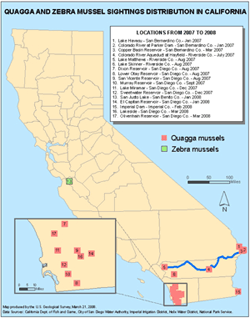What are Zebra Mussels?
The zebra mussel is a freshwater nuisance species native to the Caspian region of western Russia. It was first reported in the United States in 1988, most likely brought here in the ballast water of foreign cargo ships. Since then, it has rapidly spread and now infests waters in 20 states, creating numerous problems for water intake systems, boaters, and wildlife.
Zebra mussels look like small clams with a D-shaped shell. They usually have dark and light-colored stripes and are often found in groups. When they are very young, they look like pepper and feel like sandpaper on a smooth surface. Mature zebra mussels can grow to be up to two inches long, but most are under an inch – about the size of your fingernail.
The zebra mussel is one of the most economically damaging aquatic organisms to invade the United States. Its destructive power lies in its sheer numbers and its ability to attach itself to solid objects – water intake pipes, propellers, boat hulls, dock pilings, submerged rocks and even other aquatic animals. Zebra mussel populations can reach astonishing densities, up to 750,000 individuals per square meter in layers more than a foot thick.
- Damage to water systems
Zebra mussels are responsible for millions of dollars in economic losses to municipal and industrial water delivery systems and power plants. Colonies of zebra mussels clog filters, pipes, pumps, and power plant cooling systems. In the coming decade, they pose a multibillion-dollar threat to industrial and public drinking water supplies. - Threats to natural areas and other wildlife
Native mussels, fish and wildlife are also threatened. Zebra mussels consume available food and alter the ecology of infested waters. They are a direct threat to native mussels, accumulating on their shells in sufficient numbers to smother their hosts. In infested waters, they can wash up on beaches, covering them with thousands of broken sharp shells. The dead mussels create a foul smell. - Problems for boats
Zebra mussels can ruin boat engines by growing in the cooling system intakes and blocking water flow. They can also jam steering equipment.
Zebra mussels are excellent hitchhikers. They hitch a ride from one water body to another primarily by sticking to boat hulls, trailers, or aquatic weeds that are caught on a trailer or propeller. Zebra mussels also live in live wells, bait buckets, and bilges. Depending on their age, zebra mussels can survive outside of the water for at least five days.
Despite attempts to prevent the spread to waters west of the 100th Meridian, which runs down the middle of the U.S, zebra and quagga mussels have been discovered west of the Continental Divide. With the January 2008 discovery of zebra mussels in nearby San Justo Reservoir in San Benito County, near the Santa Clara County border, the threat of spread of invasive mussels into our waterways has increased tremendously.
Be aware that transferring a boat that has been in infested waters will allow the spread of invasive mussels. Don’t boat in known infested waters and follow boating contamination and cleaning measures recommended by the Department of Fish & Game at all times.
